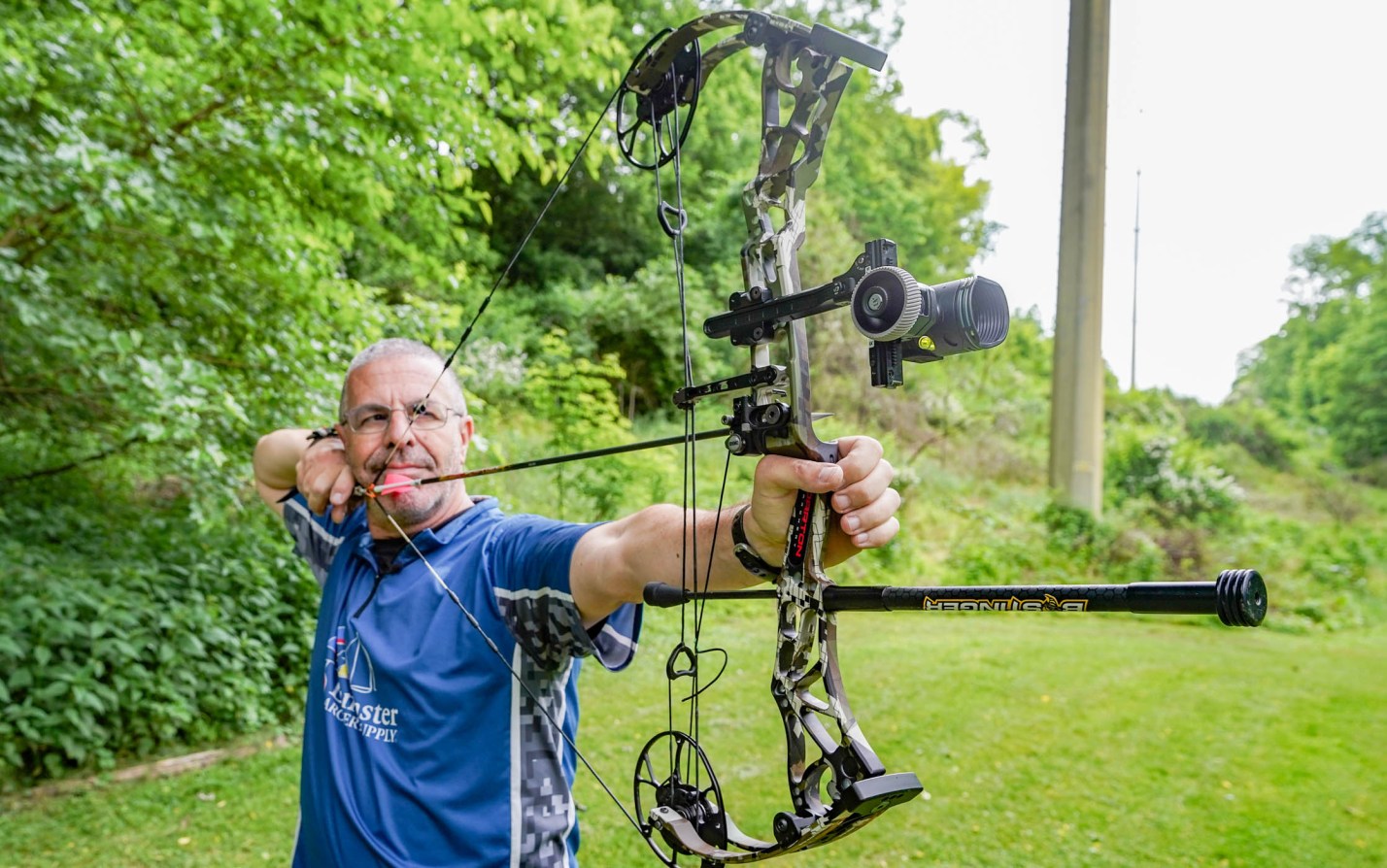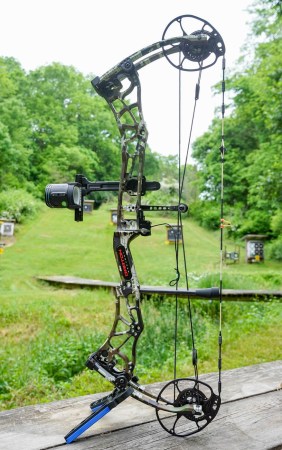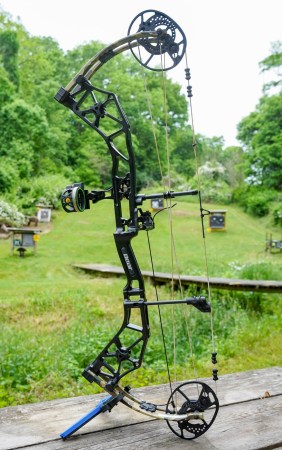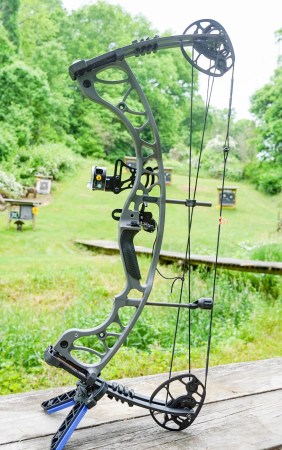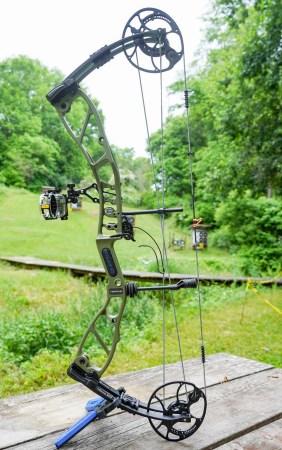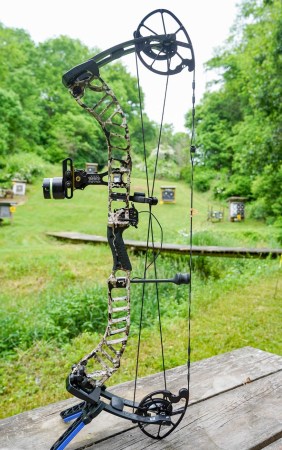We may earn revenue from the products available on this page and participate in affiliate programs. Learn More ›
With flagship compound bows from all the major manufacturers now costing north of $1,000, there is grumbling within the archery community that bowhunting gear is taxing budget-conscious hunters out of the game.
There is some evidence of this. At OL’s annual compound bow test the PSE Mach 30 DS won the editor’s choice award. It’s an incredible bow for sure, but it costs $1,800. Some folks simply will not spend this much on a bow.
Luckily, there are plenty of excellent bows available for under $1,000. You absolutely can get a well-built, tack-driving bow for a fraction of the cost of a flagship model. I tested six so-called “budget” options to find the best compound bow for the money. I can confidently say that you can be successful with any of the six, and they all exceeded my expectations in finish and performance.
But the winner stands head and shoulders above the rest. It’s a forgiving, smooth-drawing, rock-steady, super-accurate bow that costs $650. And it’s entirely made from high-end materials. There’s no looking down your nose at this “budget” bow. It’s got it all.
- Best Overall: Darton Consequence
- Runner Up: Bear Alaskan XT
- Hoyt Torrex
- Elite Terrain
- Prime Ronan
- PSE Vengeance
Best Compound Bows for the Money at a Glance
| Bow | Accuracy | Speed | Draw Weight | Draw Length Range | Length | Price |
| Darton Consequence | 1.63 inches | 297 fps | 61.8 pounds | 26-31.5 inches | 29.5 inches | $650 |
| Bear Alaskan XT | 1.81 inches | 301 fps | 58.6 pounds | 25-30 inches | 33 inches | $530 |
| Hoyt Torrex | 2.06 inches | 302 fps | 61.6 pounds | 26-30 inches | 30 inches | $699 |
| Elite Terrain | 1.96 inches | 300 fps | 61.2 pounds | 25.5-31.5 inches | 32.5 inches | $750 |
| Prime Ronan | 2.38 inches | 304 fps | 61.6 pounds | 26.5-30.5 inches* | 34 inches | $849 |
| PSE Vengeance | 1.38 inches | 301 fps | 61.2 pounds | 24.5-30 inches | 30 inches | $999 |
How I Tested the Best Budget Bows

Photo by Scott Einsmann
Bow Setup and Tuning
The bows I tested came in with varying peak draw weights. Some were 70-pound models, some were 60-pound models, and one was a 65-pound bow. So I set them all close to the 60-pound range, with a draw length of 30 inches.
I timed the cams, set the center shot to the standard 13/16 inch, and set the nocking point level. Then I paper tuned each until I got a perfect bullet. I achieved that with ease for each bow.
Speed
I shot Easton Sonic 6.0 arrows in 300 spine cut to 28.5 inches with 50-grain field points. The arrows weighed exactly 350 grains, which would be the minimum weight used to derive ATA speed ratings for each bow at 70 pounds. Each bow’s exact draw weight is listed along with its speed in the test results section.
I used a Garmin Xero C1 Chronograph to measure three shots from each bow. I then averaged those three recorded speeds for the final spec. Truthfully, many variables play into arrow speed, including the bow’s tune, the weight of the peep, and the number of speed nocks on the string. The speeds listed for each bow are reference points rather than the final word on each bow’s speed. What was surprising was how close the speeds were on all the bows I shot, and that all hovered around the 300-fps mark with draw weights in the 60-pound range.
Accuracy
Using Black Eagle Spartan arrows that weigh 435 grains, I spent several days shooting all six bows at 50 yards. Why didn’t I stick with the Easton Sonics? Well, I only had three of them, as compared to 10 Spartans. Plus, I feel the 435-grain Spartan is a better representation of a typical hunting arrow. These bows are meant for bowhunters. I wanted to shoot them in a realistic hunting configuration.
I shot the Spartan arrows at 50 yards at an NFAA 50cm field target face, with a 10cm (3.9 inch) center dot. It’s the same target you’d shoot at 50 yards during an NFAA field round.
I shot two three-arrow groups from each bow to measure, and those measurements are shown for each bow. But then I spent time shooting each bow at the same target at the same distance to get a feel for how each felt and performed.
Gear I Used for Testing
- Chronograph: Garmin Xero C1
- Bow Sights: UV Slider, HHA Tetra Ryz, Trophy Ridge React Pro, Trophy Ridge Drive
- Arrows: Easton Sonic 6.0 and Black Eagle Spartan
- Arrow Rests: QAD Ultrarest, CBE Defy, Trophy Ridge Propel, Trophy Ridge Sync, Redline Guru
- Stabilizer: Bee Stinger Premiere Plus
Other Tools Used
- LCA Scale
- LCA Draw Board and Bow Press
Best Compound Bows for the Money: Reviews & Recommendations
Best Overall: Darton Consequence
Specs
- Axle-to-Axle: 29.5 inches
- Weight: 4.3 pounds
- Brace Height: 7.5 inches
- Draw Length: 26-31.5 inches
- Let Off: 80-87 percent
- Price: $650
Test Results
- Test Draw Weight: 61.8 pounds
- Holding Weight: 9.4 pounds
- Arrow Speed: 297 fps
- Average 50-yard group: 1.63 inches

Heading into the final day of testing on the range, I had a feeling the Darton Consequence was in the lead, based on its price, its build quality, and my early accuracy testing. So in order to put it to the ultimate test I shot it at the end of the pack of bows, when I would expect my focus and strength to be at their weakest.
The timing didn’t matter. I was able to comfortably draw, aim, and shoot bullseyes with the Consequence, regardless. It seemed effortless to hold my pin on that center dot of the NFAA 50cm face and stack arrows into it.
I’m not a pro shooter. I have many flaws. But I shoot enough that I know if I’ve made a mistake as soon as I release an arrow. I also know if I have to work hard to maintain consistent accuracy or if it’s coming easily.
With the Consequence, consistent accuracy came easily. What’s more, I could make minor mistakes, but the arrows still hit the middle. That’s the Holy Grail of bows, right? One where you can shoot a bad shot, but the arrow still ends up in the middle? No doubt, a lot of the Consequence’s forgiveness has to do with the generous 7.5-inch brace height — the biggest among the test bows. The bigger the brace, the more forgiving the bow, and the Consequence has an ample brace height for a hunting bow.

Photo by Scott Einsmann
So my main attraction to the Consequence was that it was a true pleasure to shoot. Add to that the fact that it costs $650 and that it has zero composite parts. The riser and limb pockets are 100-percent aluminum. The cam is the same one used on the flagship Sequel 33. There is no plastic cable slide. The cables are connected to metal rollers at the end of the cable arm. These are all features of flagship bows, yet the Consequence is half their price.
If there is one notable knock against the Consequence, I’d say it’s the twang of the bowstring at the shot. As compound bows go, it’s a bit loud. I can’t say it’s excessive, but it is noticeable. A pair of cat whiskers tied onto the string will kill that twang easily.
The Consequence was the slowest bow in the group, with an arrow speed of 297 fps. But, as noted, it also was the bow with the biggest brace height, at 7.5 inches. That’s a full inch longer than some of the other bows. And speed is sacrificed for forgiveness with a bigger brace height. I’ll gladly give up a few feet per second for a more forgiving bow.
The Consequence got a few extra points for being one of only two in my test group offering draw lengths of 31.5 inches. It can be challenging for bowhunters with draw lengths over 30 inches to find bows that fit them — especially in the budget category.
Runner Up: Bear Alaskan XT
Specs
- Axle-to-Axle: 33 inches
- Brace Height: 6.25 inches
- Draw Length: 25-30 inches
- Let Off: 80percent
- Price: $530
Test Results
- Test Draw Weight: 58.6 pounds
- Holding Weight: 10.4 pounds
- Arrow Speed: 301
- Average 50-yard group: 1.81 inches
At $530, the Bear Alaskan XT was the least expensive bow tested. It has composite limb pockets and a hybrid cam system that employs a split yoke connected to the top limbs, which is older technology.
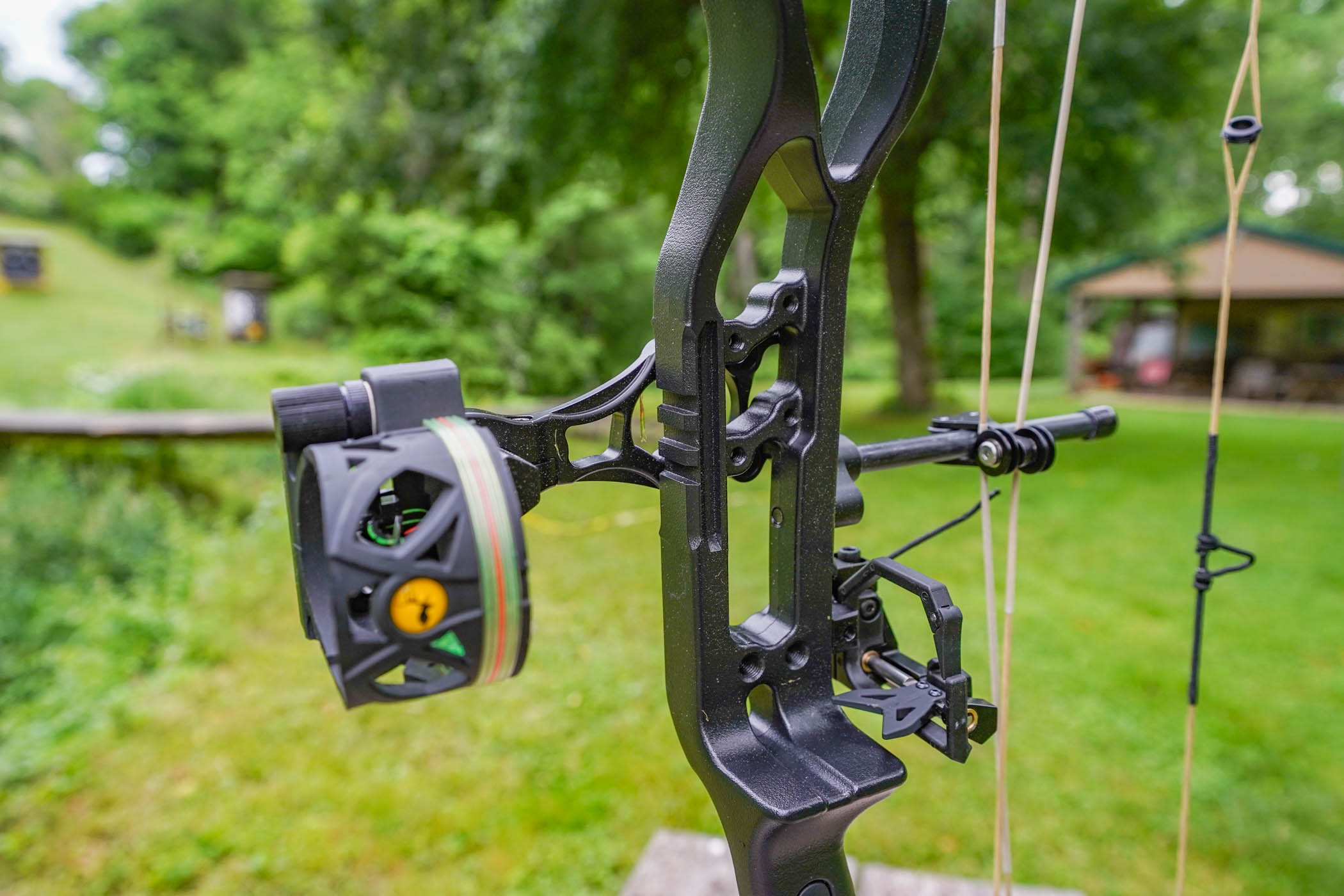
Photo by Scott Einsmann
But it includes two features seen on most flagship bows these days: a Picatinny sight mount and a dovetail arrow rest mount. The PSE Vengeance ($999) is the only other bow in this test to include even one of those features.
Surprisingly, the Alaskan XT was pretty fast. I had a 60-pound model that only drew 58.6 pounds with the limb bolts turned as tight as possible. At that weight, and with a 30-inch draw length, my 350-grain test arrow flew 301 fps out of the Bear. The fastest bow in my test shot arrows at 304 fps, but with a draw weight nearly 4 pounds heavier than the Alaskan XT.
Besides the composite pockets, where the Alaskan XT was noticeably a budget bow was in the back wall. It had the spongiest back wall of the test. What that means is it’s very easy to creep forward from the absolute full-draw position while still having the draw stops contacting the cables. When that happens, shots tend to be inconsistent.
However, as long as I paid attention to the back wall and remained in contact with it at all times while aiming, the bow shot great. My two groups for score measured 1.25 and 2.5 inches at 50 yards. I found that as long as I stayed with the Alaskan XT on the range, I was pretty accurate with it. When I jumped from bow to bow, my accuracy with the Bear suffered because I got used to the more solid walls of the other bows.
Because of its price, the features included at that price, and the performance of the bow, the Alaskan XT is an excellent compound bow for the money.
Hoyt Torrex
Specs
- Axle-to-Axle: 30 inches
- Weight: 3.8 pounds
- Brace Height: 7 inches
- Draw Length: 26-30 inches
- Let Off: 80 percent
- Price: $699
Test Results
- Test Draw Weight: 61.6
- Holding Weight: 11.8
- Arrow Speed: 302 fps
- Average 50-yard group: 2.06 inches
The Hoyt Torrex is a simple bow that gets the job done. When you see the signature Tec riser that features a bridge behind the grip, you’ll know it’s a Hoyt from across the range. That bridge helps tie the top of the riser to the bottom while aiding in rigidity. Rigidity then translates to stable aiming and less flexing at the shot.

Photo by Scott Einsmann
There’s no mistaking that the Torrex is Hoyt’s budget bow. It’s got small, composite limb pockets, a simple, plastic cable slide, and split yokes on the top and bottom cams — a feature Hoyt moved away from on its flagship bows a few years ago. Older technology and non-metal parts are hallmarks of the budget-bow class. But they don’t render a bow obsolete.
The split yokes on the Torrex make this bow a snap to tune. Simply add twists to one side of the yoke, while removing twists from the other to affect cam lean one way or the other to correct paper tears. This has always been a simple cam system to tune, and I’m a fan, even though flagship bows from all the major manufacturers have moved away from it.
There are no frills here, but that’s OK. The Torrex shoots well, but it requires a little more work by the shooter to be consistent. The back wall of the Torrex was pretty spongy compared to other test bows. But as long as I paid attention to keeping the bow at full draw, I was able to shoot decent groups at 50 yards. Aiming the Torrex improved greatly with the aid of the front stabilizer, and, ultimately, I kept my arrows inside the 10cm circle at 50 yards. For folks who like the feel and look of Hoyts, this is the budget bow for you.
Elite Terrain
Specs
- Axle-to-Axle: 32.5 inches
- Weight: 3.9 pounds
- Brace Height: 7 inches
- Draw Length: 25.5-31.5 inches
- Let Off: 85 percent
- Price: $750
Test Results
- Test Draw Weight: 61.2
- Holding Weight: 11.8
- Arrow Speed: 300
- 50-yard Group Average: 1.96 inches
The Elite Terrain is another bow that imitates the look of its flagship cousins. The riser design is signature Elite, with the bridge above the handle and the shape of the cutouts. The riser and pockets are both aluminum, so kudos to Elite for using quality parts.

Photo by Scott Einsmann
Instead of the Linear Tunable Roller that is customary on Elite flagships, you’ll find a simple plastic cable slide pinning the cables to the cable arm. Also, there’s no S.E.T. technology on the Terrain for adjusting cam lean. It’s got the old-school split yokes. And while the cam features a rotating mod for adjusting draw lengths, the Terrain adjusts in 0.5-inch increments, versus the 0.25-inch adjustments found on the flagship cams.
Speaking of draw length, it’s pretty generous on the Terrain’s cam at 25.5 to 31.5 inches. Bows that draw under 26 inches and over 30 inches are not terribly common. Because the Terrain hits both ends of the spectrum, it’s going to fit a wide audience. That’s a plus in the budget world.
Shooting the Terrain is another clue that it’s an Elite. It holds incredibly well at full draw. The draw cycle was a bit grittier, and there is a bit more vibration at the shot than you’ll find in Elite flagships, but neither is horrible. I didn’t have to work hard to shoot 2-inch groups with the Terrain, so it will perform. At $750, it’s a good buy, but it’s on the higher end of the budget bows.
Prime Ronan
Specs
- Axle-to-Axle: 34 inches
- Weight: 4.4 pounds
- Brace Height: 6.25 inches
- Draw Length: 26.5-30.5 inches
- Let Off: 80 percent
- Price: $849
Test Results
- Test Draw Weight: 61.6
- Holding Weight: 10.4
- Arrow Speed: 304
- 50-yard Group Average: 2.38 inches
As I’ve been talking about “budget” bows, I frequently mention how manufacturers will cut features from their flagship bows in building their lower-cost offerings. Strike that for the Ronan. It has two of the most notable features from Prime’s top-end bows.
First is the Core cam, which Prime developed to replace its former dual-cam system. The same Core cam has powered Prime’s flagship bows the last two years. It aligns the string and cables at full draw to maintain consistent downward pressure that keeps the cam vertical. Essentially, you never have to worry about cam lean, and so tuning is a snap.
A controversial side of the Core cam is that it is mod-specific for draw length. That means you need a specific mod for every draw length. The Ronan was the only one of the test bows with this cam type versus one with a rotating mod.
The upside of the fixed mod is that engineers believe this ensures that the cam is achieving peak efficiency at every draw length. Rotating mods, by comparison, are likely to offer peak efficiency at some draw lengths but then sub-peak at others. With a mod-specific cam, however, you have to buy a new mod any time you want to change the draw length.

Photo by Scott Einsmann
The Ronan also maintains Prime’s signature Center Grip Technology, which places the grip in the center of the riser for optimum balance. Like the flagship Primes, the Ronan holds incredibly well without any stabilizers because of the grip position. When you add stabilizers, they just help the bow aim even better.
And the aim was what was most noticeable about the Ronan. It allowed me to anchor the sight pin on that 10cm dot at 50 yards. While shooting to get a feel for the bow, I shot six arrows at a time, and I recall aiming at different parts of the dot to try to avoid smashing arrows. The Ronan produced the worst measured shot groups in my test, but I’m not going to call two sub-3-inch arrow groups at 50 yards a deficiency.
Looking solely at the performance of budget bows, the Ronan was in the running for my top pick. What knocked it down is that it’s the second-most expensive bow. It’s just over $300 less than Prime’s flagship bows, so there is some saving there, but there likely are a fair number of budget-conscious archers who will think $850 is still too much money for a hunting bow.
PSE Vengeance
Specs
- Axle-to-Axle: 30 inches
- Weight: 4.4 pounds
- Brace Height: 6.75 inches
- Draw Length: 24.5-30 inches
- Let Off: 80-90 percent
- Price: $999
Test Results
- Test Draw Weight: 61.2
- Holding Weight: 6.8
- Arrow Speed: 301
- Arrow Groups in Inches: 1 and 1 ¾
At a cost of basically $1,000, the PSE Vengeance was the most expensive bow in the test group. And at that price, it had no chance of winning the title of best budget bow, regardless of performance.
Having said that, the Vengeance is a sweet-shooting bow. It should be. It’s powered by PSE’s long-running, smooth-shooting Evolve cam, featuring a rotating mod for draw length and an adjustable draw stop that allows the user to change let off from 80 to 85 to 90 percent.

Not surprising to me, the Vengeance also produced the best accuracy score, with two measured groups of 1 inch and 1.75 inches. It held and shot like the PSE flagships that employ the Evolve cam.
As mentioned earlier, the Vengeance is the only other bow besides the Alaskan XT in my test group to include a picatinny rail for mounting a sight and a machined dovetail to allow for an integrate-style arrow rest. A nice rubber grip and an included dampener mounted to a low front stabilizer bushing round out the multitude of features on this bow.
The Vengeance is a high-end bow. It’s not a flagship, but it’s pretty darn close. Anyone should be glad to have this bow, but at $1,000, it’s hard to call it budget friendly.
Final Thoughts on the Best Compound Bows for the Money
I was thrilled with the results of the best compound bows of the money. Collectively, these six bows shattered my expectations in a good way. I fully expected to struggle to shoot consistently, and to dislike the shooting experience. There was no bow that I didn’t like. If you told me I had to shoot any one of them for a hunting season, I’d gladly do it.
- Best Overall: Darton Consequence
- Runner Up: Bear Alaskan XT
- Hoyt Torrex
- Elite Terrain
- Prime Ronan
- PSE Vengeance
